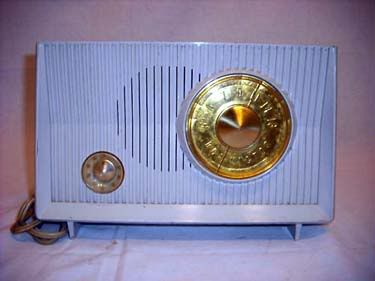I had an idea to pen some sort of radio script, some melodrama related to my love affair with all things radio, but I decided instead to cut to the chase and write on the issue at hand — The All American Five AM BC receiver.

The AA5 was the standard AM band receiver built and sold in the U.S. for more than 30 years, from the 1930s through the mid-1960s. Regardless of the name brand or model number, the AA5's vary little; they consist of the same basic 5 tube lineup.
The AA5's longevity was due primarily to its design with a minimum of parts; in other words, without a transformer it was very cheap to build in mass quantity. The design worked very well, though for those of us who dared venture inside the AA5, you could find quite a nasty shock inside.
The design meant that one side of the AC line was tied to the chassis ground, which would give you quite a surprising jolt depending on the orientation of the line cord. By the 1950s and 60s, most AA5s were being built with interlocks to help prevent shocks, and the chassis were well isolated from probing hands and fingers (those bakelite cases sure helped too).
The AA5 model I'm dealing with is an RCA model from the mid-1950s. It is identical to the one pictured with the exception of the color of the tuning dial; the one pictured has a solid gold dial, whereas the model I have has the gold dial with a light seafoam green inlay (the numbers and border are gold).
This model is the same as one my parents had at our home; I picked it up at a thrift shop in Louisville a number of years ago. It worked, albeit a little noisy … the filter caps were leaky, but it played.
For the past couple of years, the radio has been in our bathroom, on a shelf away from water. Believe it or not, it matches the bathroom quite well, and we needed a radio in the bathroom (a shower radio we received as a wedding gift gave up the ghost several years ago, and we all enjoy listening to the news in the morning as we get ready.
One morning last week, the radio didn't come on. I noticed it but thought it was unplugged. Nope, not that. With the switch on, a very low-level hum is emitted that wasn't controlled by the volume control .. hmmm….
I hadn't worked on one of these radios in … 30 years?? Well, I decided it was time to tear back into one.
The radio is equipped with an interlock; take the case apart, and it removes the power cord. Back in the “old days” of my TV/radio experimentation, I always had a “cheater cord” handy for just such instances. I haven't needed a cheater cord in a couple of decades, and I sure don't have one now — and I needed one. Without the cheater cord, I couldn't apply power easily to the radio out of its case, and I wanted to check to see if the tube filaments were lighting.
The cheater cord simply snaps in its rectangular opening; it is held in place with tabs molded into the end of the cheater cord. 60 years ago, these tabs were pliable synthetic rubber; today, they're hard-ass plastic. It took some care (and another set of hands) to get it popped out of the back of the case without also destroying it in the process.
The electrolytic caps are what usually dies in these radios, and last night I went ahead and ordered replacements (this will fix the hum); but with the cheater cord attached, I found the filaments on the tubes did not light up. Hmmm …
On the AA5, the filaments are in series; if one opens, they all go out. I'll do some continuity checks on the tubes; hopefully I can find which one is open without trying to find my tube checker. There's a chance it could be the filter caps, but unlikely. The second tube in the string is the audio output tube, and I can hear a faint hum when power is applied, so there's something going on probably that far in the string of filaments. I figure the hum is due to capacitor leakage finding a return path to ground.
I have several different AA5s in the house and attic, and all of this troubleshooting has me itching to work on those too. I have to beautiful bakelite receivers of the mid-1940s, and both need filter caps. Sounds like a good project to me!
Off to find my VOM … wish me luck!
73 es Happy Holidays … de KY4Z … dit dit
Wednesday, Dec. 8, 2010, 12:16 a.m.
As a post script, let me add that my continuity checks of the tube filaments paid off: The 50C5 audio output tube has the open filament.
Of course, to determine this, I had to find my VOM; once I found it, I realized the battery was nearly dead (and one thing that's dropping from regular household consumption is the 9V battery! I couldn't find one to put in my VOM).
I have an 25-year-old Beckman digital VOM from my days as an electronics technician … if I can find it, and IF the batter is good (sheesh!). I found my trusty old Beckman, and what luck! The battery was good! I checked the continuity of the entire tube complement, but found the opening filament on the second measurement. I just bought one on eBay that's guaranteed good, so we'll have this radio playing soon enough … I'm going to put the new electrolytics in for good measure too.
